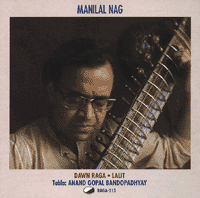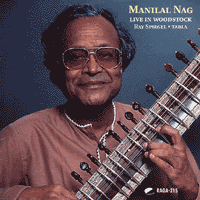
Volume 64, Number 23 : November 2, 1994

Volume 64, Number 23 : November 2, 1994
Popularity is not the sitarist's aim
By Robert Hicks
In his seat on the Indian Government's University Grand Commission,
sitarist Manilal Nag is highly regarded as an expert in the field
of Indian classical music. and as a board member for the All-lndia
Radio and Television network, he helps select artists for its
programs. While preparing for his New York debut at The New School's
Tishman Auditorium on Fri., Nov. 4, in a concert with Samir Chatterjee
on tabla, Nag had time to reflect on his role as an artist.
"As an artist, I play for my own satisfaction and for people
who can understand the real pain and depth of the music. I never
play the popular music of India. I am a classical artist. I don't
work in any institution. I am a worshipper of the arts. I try
to create an atmosphere for peace and enjoyment in the hearts
of the listeners," says Nag.
Nag and Chatterjee will perform on a two-part program, Masters
of Indian Music, co-sponsored by The New School and the World
Music Institute, with young virtuoso sarod player Tejendra Narayan
Majumdar, also in his New York debut, accompanied on tabla by
Tanmoy Bose.
Nag is the major living exponent of the Vishnupur gharana, which
retains the depth, resonance and vitality of the ancient dhrupad
style of the aalap, the base of the North Indian raga, with its
slow tempo that gradually builds in speed to a high point, unlike
South Indian music in which the tempo remains the same throughout
against which the main artist sings or plays faster by increasing
the number of notes per beat.
The son of sitar master Sangeetacharya Gokul Nag and descendent
of other distinguished sitarists, Nag was born into the tradition
on Aug. 16, 1939, in West Bengal. From age 6. he studied vocal
and instrumental music with his father, who was noted both as
a sitarist and as a composer at the University of Calcutta. From
these disciplined hours of practice, 6 to 8 per day, and additional
study with his guru for 15 years, Nag could appreciate the vocal
qualities of his chosen instrument.
"I have to follow the vocal music on sitar. The vocal is
the vital point of any instrumental music in India," says
Nag.
By 1953, Nag had been selected to stage his debut concert at the
All-lndia Music Conference, accompanied by master tabla player,
the late Pandit Santa Prasad. The next year, the young Nag performed
as a selected artist of the All-lndia Radio, working with Pandit
Anokelal of Varanasi. In the ensuing years, Nag won acclaim performing
at music festivals throughout India and abroad under the auspices
of the National Program of the All-lndia Radio.
With a 16-year-old son, Subhasis Nag, and a 23-year-old daughter,
Mita Nag, the latter selected as sitarist for the All-India Music
Conference, Nag discourages them from becoming professional musicians
because of the economic and social conditions in India. His son
is in college in Calcutta and his daughter holds an M.A. in English
from the University of Calcutta. Nag also laments the lack of
discipline among the young musicians in India, who now study only
six years before beginning public performances.
In 1973, Nag came to the U.S. for the first time to perform. That
same year, he visited England and other European sites as a performer
with the Indian Cultural group. He toured Australia in 1980 and
continued his visits to Bangladesh and Nepal. In 1985, Nag was
invited to perform throughout Japan and 1994 finds him releasing
a new CD, "Raga Lalit," with tabla player Anand Gopal
Bandopadhyay on Raga Records.
Masters of Indian Music, featuring sitarist Manilal Nag and
sarod player Tejendra Naryan Majumdar, at The New School, Tisch
Auditorium, 66 W. 12th St., Fri,, Nov. 4, 8 P.M. $16. 307-7171
or 545-7536.

